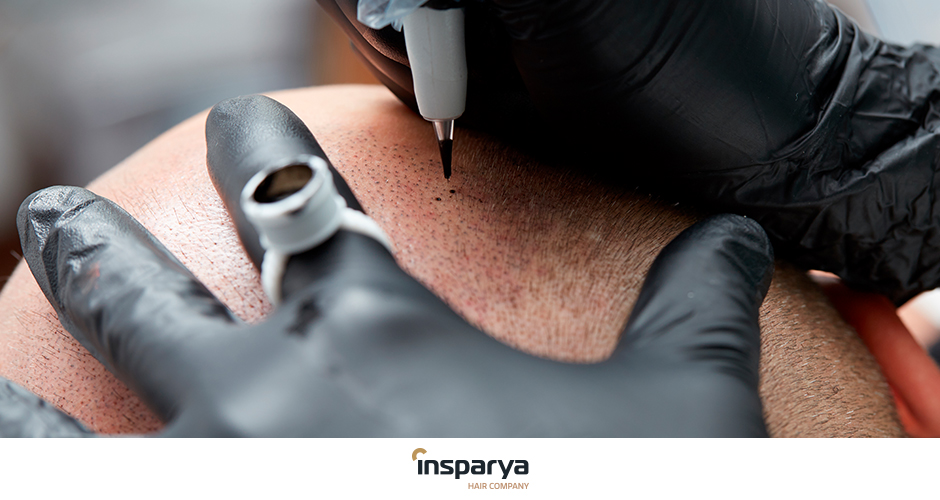
Micropigmentación capilar ¿Qué es?
- ¿Qué es la micropigmentación capilar?
- ¿Para quién es recomendable la micropigmentación?
- ¿En qué consiste la micropigmentación capilar?
- ¿Cuánto tiempo dura la micropigmentación?
- ¿Cuánto lleva el procedimiento de micropigmentación capilar?
- ¿La micropigmentación capilar duele?
- ¿Cómo cuidar la micropigmentación capilar?
- Ventajas de la micropigmentación capilar
- Desventajas de la micropigmentación capilar
- Micropigmentación capilar famosos
- Alternativas a la micropigmentación capilar
- Micropigmentación capilar opiniones
La micropigmentación capilar o tricopigmentación es una técnica no quirúrgica y semipermanente con la que se simula la salida de pelo del cuero cabelludo. El efecto se logra introduciendo pigmentos en la piel de distintos tonos y con diferentes ángulos de penetración, para conseguir un resultado lo más realista posible.
¿Qué es la micropigmentación capilar?
La micropigmentación capilar sirve para ocultar cicatrices, para dar sensación de mayor densidad capilar y para crear un aspecto de cabeza rapada en el caso de las alopecias totales y de las cicatriciales.
También se emplea para recuperar otras zonas. Así, la tricopigmentación de cejas y de barba es bastante común y logra muy buenos resultados, sobre todo si se combina con un trasplante capilar en estas zonas.
Para resumir, podemos decir que los objetivos principales son modificar, corregir, embellecer y reequilibrar de forma semipermanente determinados rasgos corporales mediante la implantación de pigmento en la piel.
¿Para quién es recomendable la micropigmentación?
Una tricopigmentación u micropigmentación capilar es útil para las personas que desean disimular cicatrices como consecuencia de procedimientos de extracción o de trasplante de unidades foliculares no realizados correctamente. Si te sometes a un trasplante capilar en Insparya no te sucederá esto, porque las marcas que dejamos son completamente imperceptibles.

Sin embargo, no siempre sucede así, sobre todo si el cirujano no tiene la experiencia ni la formación necesarias. De este modo, las cicatrices del trasplante capilar son el tipo más común de marcas que los clientes quieren cubrir con micropigmentación. Sin embargo, la micropigmentación capilar en mujeres y la micropigmentación capilar en hombres puede aplicarse también para disimular cicatrices causadas por una lesión o por una cirugía.
No hay que olvidar que el trasplante capilar es una cirugía en toda regla. Requiere un procedimiento invasivo con incisiones realizadas por instrumentos quirúrgicos. El tejido cicatricial forma naturalmente una barrera protectora sobre cualquier corte o lesión, en un esfuerzo del organismo por reemplazar las células que han sido destruidas. Por desgracia, el tejido cicatricial carece de la elasticidad y flexibilidad de la piel sana.
¿Por qué se realiza la micropigmentación capilar?
Si experimentamos un adelgazamiento del cabello o detectamos síntomas de alopecia, la micropigmentación del cuero cabelludo es una buena opción para recuperar la sensación del cabello natural. Se trata de un procedimiento no quirúrgico que puede complementar estéticamente a los tratamientos convencionales contra la caída del cabello y proporciona resultados excepcionales.
¿En qué consiste la micropigmentación capilar?
La micropigmentación capilar es una técnica de tatuaje que comenzó utilizándose para dibujar pecas y transformar las cejas sin volumen en arcos definidos. Ahora, este procedimiento ha evolucionado y se emplea también en el cuero cabelludo, con profesionales que entintan miles de puntos diminutos para imitar los folículos pilosos.
La técnica consiste en la inyección de una pequeña cantidad de pigmento en la capa superficial de la dermis del cuero cabelludo, con el objetivo principal de conseguir simular la presencia de cabello de aspecto rasurado. Se trata de un procedimiento prácticamente indoloro y, sin duda, constituye una opción para cubrir zonas despobladas logrando un efecto de pelo rasurado, si no hay zona donante para un trasplante. Sirve también en pacientes que quieren un aspecto de mayor densidad en zonas ya trasplantadas o para ocultar pequeños defectos en áreas de cabello corto, como por ejemplo, zonas cicatriciales.
Como complemento al trasplante capilar, podrá permitir cubrir extensiones más amplias si las áreas donantes presentan debilidad y no nos permite hacer un trasplante exitoso. Asimismo, la micropigmentación se puede realizar en la zona receptora, donde previamente hayamos realizado un microtrasplante capilar, para dar mayor sensación de densidad. También puede aplicarse en la zona donante, para dar también una mayor sensación de densidad.
¿Cuánto tiempo dura la micropigmentación?
Aunque la duración de la micropigmentación capilar varía según la persona, lo común es que no tengas que hacerte un retoque hasta pasados 3-4 años.
¿Cuánto lleva el procedimiento de micropigmentación capilar?
El profesional evaluará la pérdida de cabello y le hará varias preguntas al paciente, para determinar si es un buen candidato para la micropigmentación capilar. Si somos un candidato ideal, el profesional nos aconsejará sobre cómo prepararnos para el procedimiento.
También podemos hacer cualquier pregunta durante la primera visita. La duración por sesión suele ser de una hora si se va a micropigmentar una zona pequeña, pero el tiempo aumenta si hablamos de zonas más amplias.
Entrando más en detalle, esta técnica alcanza una profundidad que varía entre 0,25 y 1,75 milímetros en la piel. Esto permitirá lograr la imagen deseada sin dañar el cuero cabelludo.

¿Cuántas sesiones de micropigmentación se necesitan?
Esta técnica se realiza entre 2 y 3 veces con una duración por sesión de 1 hora aproximadamente si es una zona pequeña. En otro caso podría demorarse más tiempo, dependiendo del tamaño de la zona a tratar. Teniendo en cuenta que es indolora, resulta un proceso relativamente sencillo y rápido de realizar.
¿La micropigmentación capilar duele?
Los tratamientos de micropigmentación capilar en mujeres y de micropigmentación capilar en hombres son prácticamente indoloros y rápidos.
¿Cuánto tarda en caerse la costra de la micropigmentación?
No suelen aparecer costras con la micropigmentación. Una vez finalizado el proceso es posible que el cuero cabelludo se quede ligeramente irritado o inflamado debido al uso de las agujas, pero no es algo preocupante. Con dejar pasar unas horas el cuero cabelludo volverá a su estado normal. Es posible que algún poro expulse algún exceso de tinta, pero de ningún modo afectará al resultado final.
¿Cómo cuidar la micropigmentación capilar?
Después de una micropigmentación capilar este es su único cuidado: utiliza una crema hidratante a base de petrolato, como Aquaphor o Vaselina, dos veces al día.
¿Qué no hacer después de la micropigmentación capilar?
Después de una micropigmentación capilar es recomendable, para su cuidado, no lavar la zona, tomar el sol ni tocar el área de trabajo durante los 4 días siguientes al procedimiento.
Ventajas de la micropigmentación capilar
Es un tratamiento que exige una gran precisión para transmitir una sensación natural, tanto en hombres como en mujeres. Entre los pros de la micropigmentación capilar, encontramos:
- Los pigmentos son inocuos y bioabsorbibles.
- Resulta menos doloroso que un tatuaje, pero se pueden eliminar las molestias casi por completo aplicando bloqueo anestésico locorregional en casos seleccionados.
- No exige pasar por quirófano, puesto que no es un tratamiento quirúrgico.
- El resultado es inmediato. No hace falta esperar mucho para ver el efecto prácticamente definitivo: apenas 2-4 días, aunque el color tarda cerca de 4 semanas en estabilizarse.
- Tiene un corto período de recuperación, durante el cual se puede hacer vida normal sin necesidad de bajas laborales.
- Son necesarios muy pocos cuidados tras la micropigmentación. Solo es importante no mojar la cabeza ni sudar los 3 días siguientes.
- Apenas se dan efectos secundarios, como mucho se puede producir un leve enrojecimiento de la piel.
- Es muy útil para mejorar los resultados de otros tratamientos, como el trasplante capilar.
- Es semipermanente, por lo que si no te convence el resultado basta con no repetir la intervención o, si lo deseas, aplicar láser para eliminar los restos de tinta.
Desventajas de la micropigmentación capilar
Pero no todo iban a ser pros en la tricopigmentación. Hay algunos puntos a tener en cuenta antes de realizarse una micropigmentación capilar:
- Tu look será siempre el mismo si optas por un efecto rapado.
- No tendrás el tacto, la textura o la protección del cabello.
- No es una solución definitiva, por lo que son necesarios retoques entre los 3-5 años posteriores. Eso sí, suelen ser más económicos que el primer tratamiento.
- Con el paso del tiempo el color se va difuminando.
Micropigmentación capilar famosos
Algunos famosos que se han realizado tratamientos de micropigmentación capilar son Vin Diesel, Jamie Foxx y Alex Beresford.
Alternativas a la micropigmentación capilar
La micropigmentación no aporta el efecto 3D que sí nos ofrece un trasplante capilar, así que esta técnica es una alternativa con, además, resultados muy naturales y duraderos. Pero ambas técnicas pueden ser complementarias y ayudarnos a superar la pérdida de cabello. Elijamos la técnica que elijamos es muy importante ponerse en contacto con profesionales como los que integran el equipo de Insparya.
Micropigmentación capilar opiniones
El doctor Carlos Portinha, Chief Clinical Officer de Insparya apunta que, aunque la micropigmentación capilar no es un verdadero tratamiento capilar, cuando está bien hecha puede ser un buen complemento, al simular la presencia de pelo rapado. El efecto será mejor en función del cabello que tenga el paciente y la habilidad del técnico que lo lleve a cabo.
En Insparya nuestra MPC es realizada solamente por personal de enfermería con formación específica en esta técnica, con pigmentos naturales y dispositivos avanzados y muy precisos.




